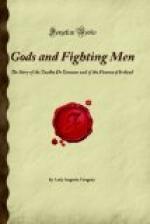“The larger Irish legendary literature divides itself into three cycles—the divine, the heroic, the Fenian. Of these three the last is so well-known orally in Scotland that it has been a matter of dispute to which country it really belongs. It belongs, in fact, to both. Here, however, comes in a strange contrast with the other cycles. The first is, so far as I am aware, wholly unknown in Scotland, the second comparatively unknown. What is the explanation? Professor Zimmer not having established his late-historical view as regards Finn, and the general opinion among scholars having tended of recent years towards the mythical view, we want to know why there is so much more community in one case than in the other. Mr O’Grady long since seeing this difficulty, and then believing Finn to be historical, was induced to place the latter in point of time before Cuchulain and his compeers. But this view is of course inadmissible when Finn is seen not to be historical at all. There remains but one explanation. The various bodies of legend in question are, so far as Ireland is concerned, only earlier or later, as they came into the island with the various races to which they belonged. The wider prevalence, then, of the Finn Saga would indicate that it belonged to an early race occupying both Ireland and Scotland. Then entered the Aryan Gael, and for him henceforth, as the ruler of the island, his own gods and heroes were sung by his own bards. His legends became the subject of what I may call the court poetry, the aristocratic literature. When he conquered Scotland, he took with him his own gods and heroes; but in the latter country the bardic system never became established, and hence we find but feeble echoes of the heroic cycle among the mountains of the North. That this is the explanation is shown by what took place in Ireland. Here the heroic cycle has been handed down in remembrance almost solely by the bardic literature. The popular memory retains but few traces of it. Its essentially aristocratic character is shown by the fact that the people have all but forgotten it, if they ever knew it. But the Fenian cycle has not been forgotten. Prevailing everywhere, still cherished by the conquered peoples, it held its ground in Scotland and Ireland alike, forcing its way in the latter country even into the written literature, and so securing a twofold lease of existence ... The Fenian cycle, in a word, is non-Aryan folk-literature partially subjected to Aryan treatment.”




